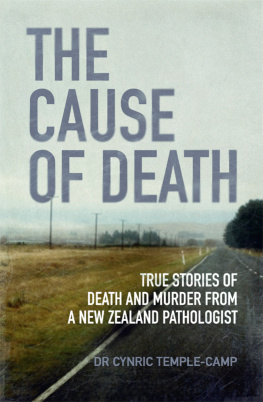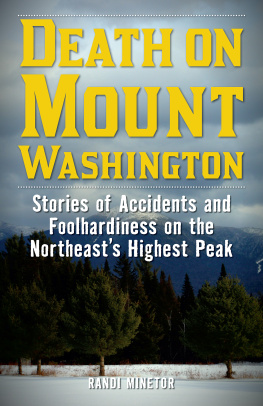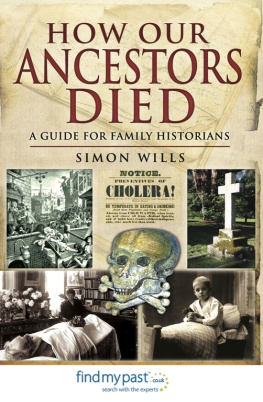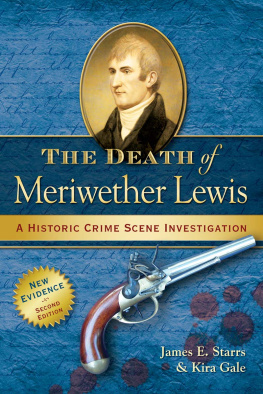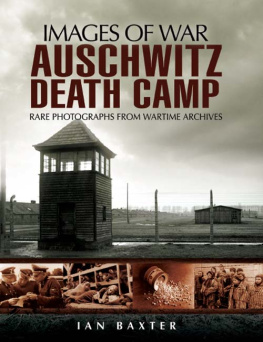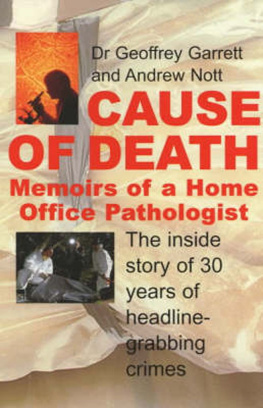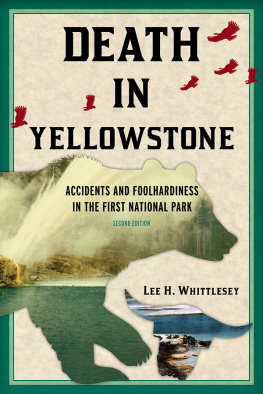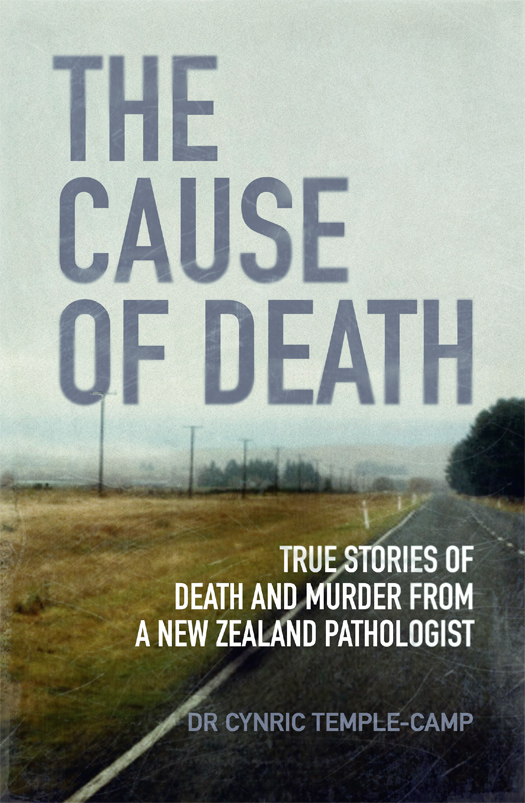CONTENTS
Guide
Message from the author, Cynric Temple-Camp
ROYALTIES FROM THE SALE OF THIS BOOK
My office overlooks the rescue helicopter landing pad at Palmerston North Hospital. I am lucky to be able to watch the crew lifting off in their awesome machine just metres from the window. I see them scramble on average once a day, on missions to help the distressed and those who are injured. Their missions are literally a matter of life and death. They deliver the living to the waiting medical services. The dead come to us. They have been involved in so many of the cases I have investigated, including several events in this book. We all owe them a debt for the unceasing vigil they keep and the help they bring in times of tragedy. It is fitting that these tales belonging to the dead stand as a tribute to the work of the rescue teams.
I have therefore pledged to give all royalties from the sale of this book to the Palmerston North Rescue Helicopter, an essential emergency service for the Manawatu-Whanganui region.

HarperCollinsPublishers
First published in 2017
by HarperCollinsPublishers (New Zealand) Limited
Unit D1, 63 Apollo Drive, Rosedale, Auckland 0632, New Zealand
harpercollins.co.nz
Copyright Cynric Temple-Camp 2017
Cynric Temple-Camp asserts the moral right to be identified as the author of this work. This work is copyright. All rights reserved. No part of this publication may be reproduced, copied, scanned, stored in a retrieval system, recorded, or transmitted, in any form or by any means, without the prior written permission of the publisher.
HarperCollinsPublishers
Level 13, 201 Elizabeth Street, Sydney, NSW 2000, Australia
Unit D1, 63 Apollo Drive, Rosedale, Auckland 0632, New Zealand
A 53, Sector 57, Noida, UP, India
1 London Bridge Street, London SE1 9GF, United Kingdom
2 Bloor Street East, 20th floor, Toronto, Ontario M4W 1A8, Canada
195 Broadway, New York, NY 10007, USA
ISBN 978 1 7755 4109 7 (pbk)
ISBN 978 1 7754 9140 8 (ebook)
A catalogue record for this book is available from the National Library of New Zealand
Cover design by Darren Holt, HarperCollins Design Studio
Cover images: Road by Jill Ferry/Getty Images; scalpel by shutterstock.com
The dead baby is gone, returned to her parents, but her presence lingers in the building. Questions have arisen from her death that remain like an unquiet spirit.
She presented as just another cot death, or SUDI (Sudden Death in Infancy) case. That, on my advice, was the Coroners preliminary finding. Her little corpse was flawless, both externally and internally. If it werent for the bluish pallor that had replaced the glow of vitality on her alabaster skin, she would have been the very picture of a healthy, well-cared-for little girl, plump and perfectly formed.
I had performed the usual array of tests. I had X-rayed her and examined the films minutely, looking for any evidence of the multiple rib and other fractures, old and new, that are known to indicate abuse, or what was once called Battered Baby Syndrome. But the films were pristine, as I knew they would be. Its never quite that easy.
Next, there was an array of more invasive tests: careful and difficult dissections, using small scissors and scalpels specially designed for the task, for the purpose of collecting samples for detailed examination. I took spinal fluid by doing a lumbar puncture. This was negative for meningitis, or indications of any of the other, rarer diseases that can affect the brain and nervous system and cause sudden illness and death. I took swabs from the lungs, the throat, and the spleen, but there was no indication the infant had been carried off by an overwhelming bacterial infection such as by Haemophilus influenzae, which can cause rapid swelling of the larynx and a death by suffocation that is nearly as fast as meningitis.
I collected blood and tissue for the lab to look for a rare condition called QT syndrome. I had encountered this before, but it wasnt the cause of this little girls death. I inserted a needle into the babys sightless eyeball to extract fluid so that her electrolyte levels could be measured, but there were no abnormalities in the balance of sodium and potassium. And of course, I had taken tissue biopsies from every organ, fixed them on slides and, later, examined them under the microscope.
There was nothing out of the ordinary whatsoever.
It bothers me that she had died while being looked after by the babysitter. But I have come to the end of the set of investigations that the autopsy comprises, and I am no closer to determining a cause of death. It bothers me, but it wont be the first unresolved mystery Ive had in my time and it certainly wont be the last.
And now like an awful slow-moving dream, two years later it was all happening again to the same family: to her sister. Her paediatrician had visited me to discuss the case. Her sister died of cot death two years ago, he said.
I remember, I said. I did the autopsy then.
So you remember she was with a babysitter the night she died. I told the family they should think carefully before they ever left their little one with that sitter again. The babysitter was a family friend and they supported her. But guess who was looking after her the night the second child died?
I stared at him.
Thats got to be coincidence, doesnt it?
Well, Im not so sure. Because over the last few months, theyve brought her in several times for apnoeic attacks.
Interesting, but...
And guess who was looking after her every time she stopped breathing in her sleep.
The babysitter? Really?
He nodded.
The phone rings. Its my colleague, Dr Bruce Lockett, who is leading the investigation this time.
Cynric, you wont believe this, he says.
I listen as he tells me what has happened, and what he has found.
What do you think it means? I ask.
He isnt sure.
Who can tell us what this means? I think aloud.
If anyone can, it would be David Becroft in Auckland, says Bruce.
Both of us know that this is a step forward. I already feel a slight tingle of anticipatory excitement. We might get a resolution, after all.
Because, in the end, thats what the whole science of pathology is based upon: the belief that every death is a question that deserves that demands an answer.
* * *
Some of the stories in this collection have been reported elsewhere. Others are untold stories, relating my part in the unexpected deaths and accidents that have befallen others. I believe the stories of the dead should be told, as quite apart from anything else, they are our story, too. For as much as we dont like to talk about it or even to admit it to ourselves, death is our common destiny.
Whats more, the living can learn much from the deaths of others. That is the whole point of pathology (literally, the study of death). From an analysis I once did on the many autopsies I have performed on people who have died in hospital, I have determined that only 40 per cent of patients die with the benefit of a correct diagnosis. In another 30 per cent, the right organ system is targeted, but the precise diagnosis has been wrong. For the remaining 30 per cent of patients, the diagnosis has failed to identify the correct organ, let alone the nature of the disorder. My findings are consistent with similar studies everywhere, even emanating from such an august body as Americas prestigious Mayo Clinic.

